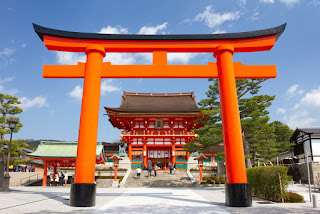
Kyoto, Japan - March 19, 2013: A giant torii gate in front of the Romon Gate at Fushimi Inari Shrine's entrance. Fushimi Inari Shrine is the head shrine of Inari, located in Fushimi-ku, Kyoto, Japan. It is famous for its thousands of vermilion torii gates, which straddle a network of trails behind its main buildings.
Shintoism is an ethnic Japanese religion that focuses on the belief that spiritual power is manifest in natural places such as mountains, rivers and other aspects of nature, including humans and animals. There are no Shinto founders, but some of its practices date back to the 8th century. As an ancient religion, Shinto was founded in small villages and then gradually spread to Japan. Eventually it became a recognized religion. Shinto does not have a Bible, but there are some sample texts. Shintoism as a religion or belief system was originally created to differentiate native Japanese beliefs from Buddhist beliefs that began in the 6th century. Therefore, it is possible to practice both Buddhism and Shinto as they do not contradict each other.
Shintoism was born in Japan, from folk belief and nature worship in small villages in Japan. It gradually grew across Japan and was institutionalized as a religion called Shintoism.
Shinto is derived from the Chinese words ‘shin tao’, which mean ‘the way of kami’.
The virtue of Shintoism is Jyoumei Seichoku.
Shinto followers believe that gods or spirits, referred to as kami, can manifest in anything in nature. This makes worshipping things like mountains and stones, and even people possible.
Gods of Shintoism stretch from ancestors of the family, he region, people who died a tragic death, or made a great achievement to the world, ancient gods from old texts, nature itself, the weather, terrain and so on.
There are five main distinguished expressions of Shintoism including Shrine Shinto (worship at local shrines), Imperial Household Shinto (rites performed on imperial grounds by the imperial family), Folk Shinto (folk beliefs and practices), Sect Shinto (sects with founders and sacred scriptures), and Koshinto (based on pre-Buddhism Shinto).
There are so many gods in Shintoism, there’s a phrase called “Yaoyorozu no Kami” in Japanese. Yaoyorozu means 8 million.
Shintoism’s model texts are called Shinten and include Senmyou, Kogo Shuui, Nihon Shoki, and Kojiki.
In Shintoism, nature and god are viewed as one.
There are 11 rituals, called ‘Saishi’ or ‘Omatsuri’ that are performed in the Shinto religion. These rituals connect gods and people together.
Shintoism’s gods are considered to be guardians of the people.
In Shintoism wrong-doings are impurities that need to be cleansed for peace of mind.
In Shintoism, gods are close and familiar beings.
The purification ritual in Shintoism is referred to as Misogi.
In Shintoism, people can be worshipped as gods. People who did great things for Japan can be worshipped too.
Shinto shrines are referred to as Jinjas. It is taboo to do anything wrong in these shrines.
A famous Shinto god is Ujigami. Ujigami is a god that is worshipped by the people living in a certain region. By worshiping this god, people prayed for the god to guard the region.
Jinjas are usually located in beautiful settings in nature, and each year each Jinja celebrates with a festival that includes food and beverages to pay respect to the kamis.
Since Shintoism started off from folk belief and nature worship in small villages, Shintoism doesn’t have a clear holy text written down like the Bible in Christianity. Instead, “Kojiki”, “Nihon Shoki”, “Kogo Shuui”, and “Senmyou” are considered model texts.
Famous Jinjas include Yasukuni Shrine in Tokyo, Hokkaido Shrine in Hokkaido, and Meiji Jingu in Tokyo. There are approximately 80,000 Shinto shrines in existence today.
In Shintoism, there is no prophet, or founder. Instead, from the Nara period, Shintoism was reconstructed with Buddhism as one religion.
Some of the oldest shrines in Japan include Fushimi Inari, Izumo Taisha, and Tsubaki Grand Shrine.
In Shintoism, rituals called Saishi are a way to connect people and gods.
The entrance to a Jinji is a gate. This gate is called a Torii and people and gods must enter and exit through this gate.
There are 11 types of Saishi performed in Shintoism.
When a child is born in Japan their name is added to a list as a local shrine. This makes the child a ‘family child’. When the person died the person becomes a family spirit (kami).
Saishi are performed at Shinto shrines.
Those who work at the Jinja, coordinating Saishi, servicing the shrine etc… are called Shinshoku (male) and Miko (women).
Saishi are done in 3 compositions.
Shintoism has a large number of gods. This large number is often mentioned in the phrase ‘Yaoyorozu no Kami’.
A Torii is built to show the beginning of a sacred place of the Jinja. It is believed that the god enters and leaves through a Torii. People visiting the Jinja must go through the Torii too.
Yaoyorozu means 8 million. This means that there are believed to be millions of kami (gods).
The main Saishi of the Jinja is called the Taisai.
The gods of Shintoism are usually guardians of the people, but some can be evil.
During the Saishi, the Omikoshi is a vehicle where the god sits.
The most important Jinji (shrine) in Japan is at Ise. This shrine is dedicated to Amaterasu – the sun goddess.









